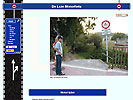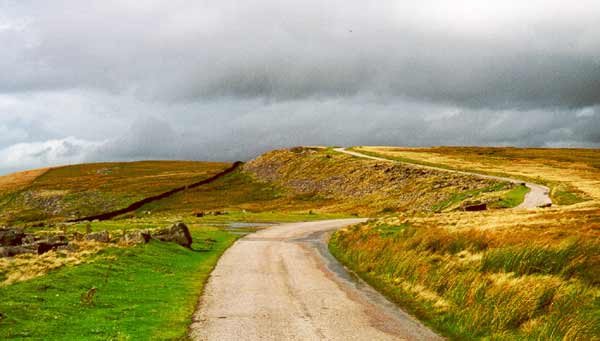
Whether you go touring for a day or a weekend, or want to have a vacation riding on your motorcycle, sometimes it is convenient to be able to cover long distances on your motorcycle.
Is that possible with every motorcycle or isn't it? What do you have to do to stay for hours in the saddle without getting tired or getting a sore butt? How many miles can you cover in an day?
This page tries to formulate the answers.
![]() Er is een Nederlandse versie:
Er is een Nederlandse versie:
https://www.luiemotorfiets.nl/tips/lange-afstandrijden/
The motorcycle itself
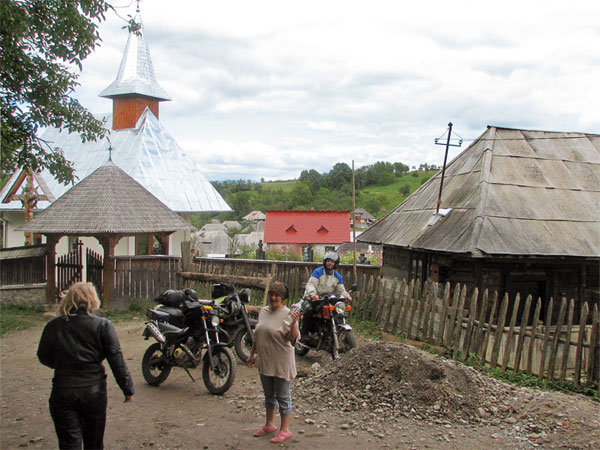
Touring motorcycle
The fact that "touring motorcycles" form a separate category might be interpreted as if other motorcycles are not suited for long distances. But that's a misunderstanding.
A touring motorcycle has several properties that make it capable to cover huge stretches of interstates (or Autobahn), loaded with luggage and a passenger, offering comfort all the way.
Those properties are: heavy in weight (so you will hardly notice the extra weight of luggage and a passenger), heavy in performance (so you can easily ride 200 kilometers an hour with all that luggage and your passenger), a lounge stair for a saddle, and a fairing that makes it feel like you ride in a car.
Interstate or no interstate?
It seems so efficient, taking the interstates to reach the place where you want to spend your holidays. That's what you are used to in your car, and after all, it's the fastest way to get there.
And if you're a sports bike rider, it gives you the possibility to open the throttle a bit on the Autobahn, on the way to the Alps.
But do think about it:
The car is a means to get you from A to B, from your home to your
holiday destination. The motorcycle, on the contrary, is a vehicle
to enjoy riding while you ride from A to B, while you're riding
from your home to your holiday destination.
Long distance motorcycles
When you travel on smaller roads, your holiday starts right at your front door. And when you travel that way, you will experience that in fact almost any motorcycle is a long distance motorcycle.
The photograph here shows a Moto Morini 350cc, a Yamaha Tricker 250cc, and a BMW R1100GS 1100cc. All three in Romania, after having covered a distance of between 2000 and 3000 kilometers (the Morini from Germany; the Tricker and R1100GS from the Netherlands).
And it wasn't hardship or anything like that. Only a matter of deciding that riding *is* your holiday.
Sitting comfortably for a long time
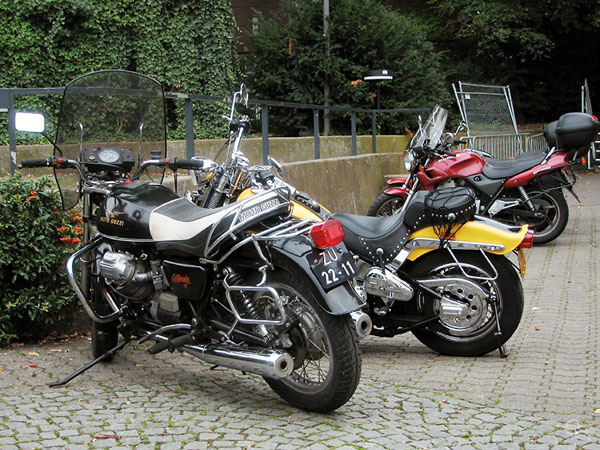
Saddle
A saddle that stays comfortable is, counterintuitively, hard. Not hard like a stone, but so hard that you don't " sink in" it when you get on your bike.
If you do sink in your saddle, there will be only one way to sit: you will have to stay in one posture. And when you spend hours in the saddle, you will have to be able to change the way you sit from time to time. A hard saddle allows that.
Flat instead of preformed
Because of exactly the same reason, a flat saddle is better than one that has a pre-formed shape.
The motor Guzzi California that you see in this picture has a perfect saddle: broad and long and flat, so you can move around to sit in different postures.
The Harley behind the Guzzi has a saddle with a preformed sunken area for your butt, where you will sink in. It will feel really comfortable at first, but not on the long run.
The Honda behind the Harley has a border at the place where the buddy area meets the saddle for the rider. That border hinders the freedom to sit at the rear end of the seat.
Knees and legs
When you are able to sit more at the front or at the rear end of the seat, your knees will be glad too, as they will be bent in a different angle, each time you change position.
Rest eat and drink
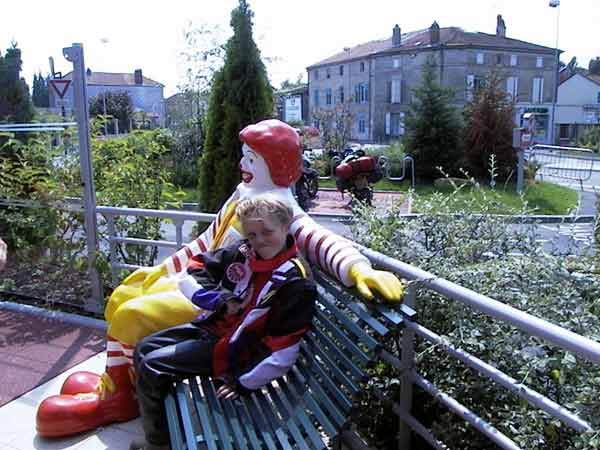
Take a break
Make sure you take a break before you get tired. Stretching your legs from time to time will have the result that you are able to ride much longer before getting tired. When you find the ideal place for a break, enjoy it for a while.
Eating and drinking
The same applies for eating and drinking: eat or drink before you get hungry or thirsty.
Put some candybars and cartons with soft drinks in your tankbag (buy them before you leave, and when they're finished, buy them at gas stations): in that case you will always have something to eat and drink during a rest-break.
With respect to dinner, all depends on your priorities. McDonalds (or likewise) is ideal for when you want to be finished soon (or for when you want to have warm food twice a day, which works very well when you are riding the whole day); dinner in a picturesque restaurant costs more time, but adds lots to your trip. A third posibility is to prepare your own food on a camping. In that case, you might want to stop riding before it gets dark, which shortens your mileage.
Dinnertime
Remember that dinnertime is often different from what you are used to. The French start at eight; Italians at nine, and in Spain people don't eat before ten. In those three countries, the main meal is at noon.
Hearing protection
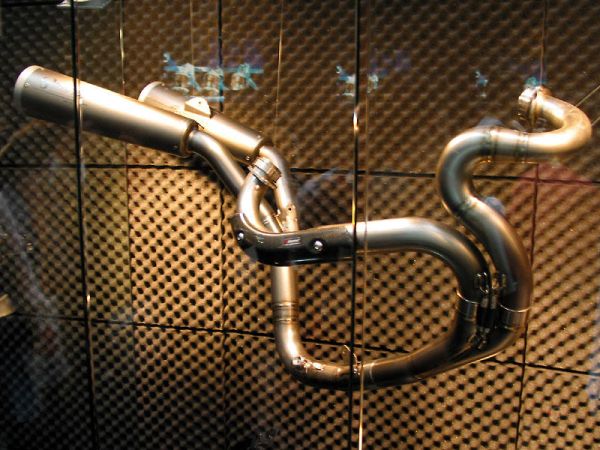
Noise
In general, it is not the exhaust pipe that is the problem for your ears, on motorcycle. It is the sound of the wind.
There are many factors that have influence on that noise: helmets can be quiet or noisy, a fairing may increase or (seldom) decrease the noise, the position of your head has influence, etc.
But even if you would be able to get the minimum of noise, you still would need hearing protection.
High pitched tones
Especially the high pitched tones damage your ears. On a motorcycle: the high-pitched noise from the combination of the riding wind and your helmet.
The longer your are in the circumstances that your ears hear loud high tones, the more damage in your ears.
And even if you would not mind, you will notice that you will be much less tired when you cover long stretches with hearing protection than without.
Which hearing protection?
Drugstores sell yellow foam ear plugs. They do function, but they are sometimes hard to push into your ears, and they filter all the sound; not just the high tones.
Alpine earplugs, that are sold at motorcycle shops, are easier to apply, and they come with filters that take away the damaging tones, but let you still hear the sound of your engine and sirens, for instance.
Which kind of roads?

Choose the right roads
If you want to cover many kilometers, you'd better not choose the really narrow roads: you won't get far.
Some countries have designated routes as an alternative for interstates (or motorways).
Bison futé
In France, those alternative routes are called Bison Futé.
In most cases, they guide you through beautiful landscapes, and are easy to follow because of the signs, showing the word "Bis" and the city at the end of the route.
There is a Michelin map of France (the blue one) that shows these routes.
Ferienstrassen
In Germany, there are many so-called "Ferienstrassen" with signs, and you often can follow them for a long time. The Romantische Strasse.
There is an overview, and many Ferienstrassen have their own website. ADAC maps show them.
Planning your route
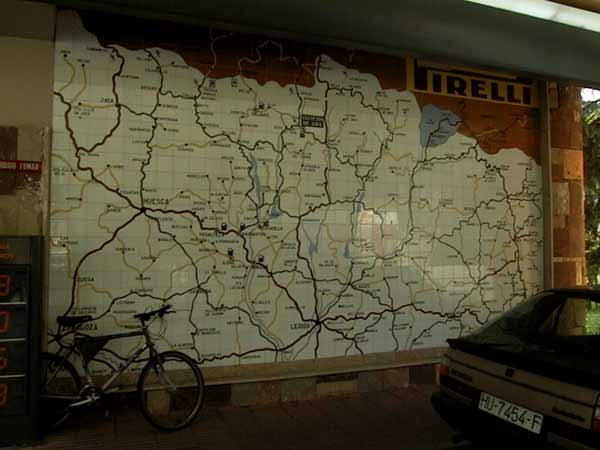
The shortest route
If you travel with a GPS, you can just take the shortest route. You will then be navigated via narrow roads, that would be hard to navigate when you would use a map (in that case, you would have to stop at every crossing, to look which way to go): the GPS will tell you which way to ride.
Disadvantages are that you miss the pleasure of planning a route yourself, and that narrow roads will not allow fast progress, even if you don't have to worry about navigation. So, of you want to cover long distances, this is not the fastest way to go.
Coincidence
Of course, you can do lots of research before you leave, with routeplanners and such, but keep in mind that you should leave space for changes of your plans. The road is more boring than you had imagined? You enter an area with terrible weather? Suddenly, you see a sign with the name of a town you always wanted to visit? Change your plans!
Line with a marker
My way of planning a route, is to take a marker in the morning, before we leave, and draw a line next to the roads I want to follow that day (and at the end of the day I draw a line in different colour for the route we *did* take).
For a nice route:
 - Look for hilly country, or mountains (high and steep mountains are marvelous
to ride through, but remember that your average speed will drop considerably).
- Look for hilly country, or mountains (high and steep mountains are marvelous
to ride through, but remember that your average speed will drop considerably).
 Look for the smaller roads (in Michelin-colours: yellow or white roads,
or narrow red ones).
Look for the smaller roads (in Michelin-colours: yellow or white roads,
or narrow red ones).
 Look for roads that don't connect two big towns. Roads that go from nowhere
to nowhere, preferrably with lots of alternatives, are probably not crowded.
Look for roads that don't connect two big towns. Roads that go from nowhere
to nowhere, preferrably with lots of alternatives, are probably not crowded.
 Look for roads with a green line on the map.
Look for roads with a green line on the map.
Reading the map
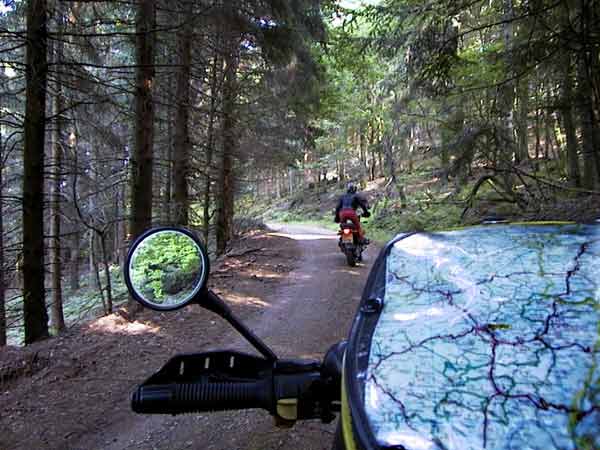
Clear maps
Obviously, you need good maps.
When you compare maps in a shop, try to look at the differences in details. That's what makes Michelin such a good mapmaker (yes, I'm a big fan): their maps show, on the same scale, much more details than those of other map makers, while the maps are very readable at the same time.
Details
Something that you can only check while riding, is how a map shows detail-situations: sometimes a T-junction on the map is, in reality, an ongoing road with a byway to the left. Using such a map, you very easily make mistakes.
Height differences
Another requirement for a map is that it should show lines for the elevation. When you can't see the elevation somehow, a map is useless (unless you use it for overview purposes).
On the road
If you navigate using maps, and you have a passenger, you can fit the map on the back of your coat (in plastic). Depending on the motorcycle and the way of riding, the passenger doesn't always have his or her hands free to use to hold the map, and holding a map in your hands all day isn't really convenient.
Tankbag
When you ride without a passenger you will need a tankbag with map pocket. Look for a tankbag with a big and watertight map pocket: the map should not get wet with each drop of rain.
Touratech has such a tankbag.
An aid for your navigational skills is a list with names of cities or
villages and road numbers, which you fold at the side of your map (leaving
the route you want to take visible, of course).
It helps deciding which road to take at crossings.
If you navigate using a map, following a Bison futé or Ferienstrassen helps very well.
How many miles in a day?
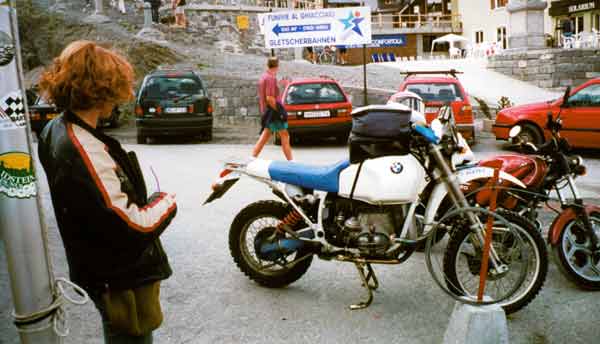
Passes
When your route contains mountain passes, remember that they might be closed outside the summer. Sometimes, you will have to take a very long detour.
The figures that are shown on maps, are minimum numbers: during those months, the pass is certainly open (or the map shows the maximum of the months for a closed pass), apart from extraordinary circumstances.
In summer, passes can be crowded on the top, as you see here.
Through towns
It's no problem at all to pass through a town from time to time (much more fun and less boring than the official road around the town), but of course, you will probably loose some time.
How many miles?
All in all, it's very difficult to predict daily kilometers, when you travel this way. It will probably be something between 500 and 800 kilometers.
But those kilometers are worthwhile vacation kilometers!
Other countries: traffic laws and habits
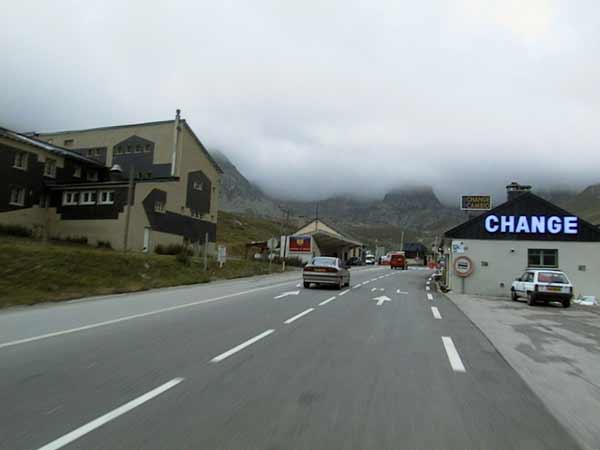
Habits
Remember that traffic rules and (much more important!) habits may be considerably different from what you are used to at home.
In Scandinavia for instance, people obey ridiculously to the maximum speeds that are signposted. They hit their brakes far before they pass the sign telling them to drive 50 km/h.
Make way for who's faster
In lots of countries (all of Scandiavia, Poland, Greece, almost anywhere except in Holland), people go to the side of the road to make way for everybody who is faster. They use the space for emergencies, if there is any. (Foreigners coming to Holland: nobody even thinks of doing that for you over here...). Being a motorcyclist, you will be the one who is faster, most of the time, but please do the same when you see someone in your mirror who is faster than you!
Be very alert in those situations (also in the case that you are the one who passes), because the utter right side of the road is often also used by slow traffic, tractors and donkeys and so on.
Maximum Speeds
In France, almost everybody drives above the maximum speed (although I must say, that pleasant habit of the French seems to become something of the past...). Official maximum speeds differ from country to country!
In France and Italy, people are used to motorcyclists riding between their lane and the lane of the oncoming traffic, when it's possible (almost always, it's possible ;-)
In Italy, people drive more "creative" than in Holland. You will be able to make very stupid mistakes; everybody else will cover up for you. Be pepared to cover up for somebody else's mistakes as well!
In Spain, people in towns and villages really expect you to ride 50 km/h at most, because they are used to it.
Try to adjust
So try to feel the "traffic habits" in the country you are riding through. That's even more important than the official rules and signposts. Try to adjust to the habits of that country, and don't think that the system of your own country is superior.
Other countries: signs and situations
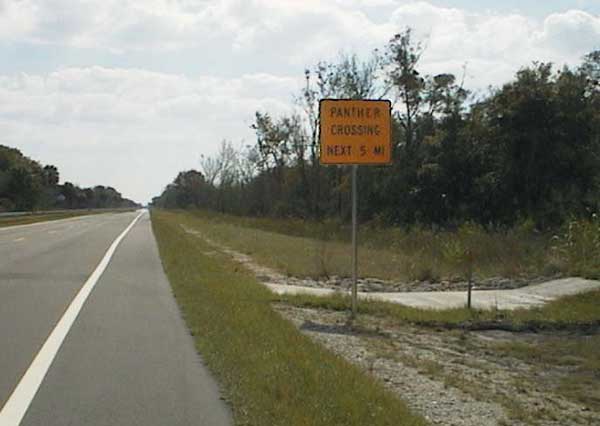
Differences
Before you leave, it's possible to obtain information about different traffic ruls and signs of foreign countries. Check the AAA or ADAC or however the Automobile Association is called in your country.
Advisory speed
Remember that in Holland, we are treated as small children with respect to advisory speed. In lots of countries, those advisory speed are much more realistic. You will have to get a feeling for those advisory speeds. In some countries, they are very consistent; in other countries they are much too low at one time, and in the next situation you wonder how anybody gets through that corner at that speed. So don't multiply them with two, like you might be used to in Holland.
Quality of the road
Roads are often less well maintained than people are used to in Holland, especially in places where bitumen is damaged by frost in winter. In summer, roads are often very slippery in places where there is seldom rain during the summer: oil and such is never rinsed away.
Tunnels
Tunnels: some of them are dark, very dark, and when you enter such a tunnel without lights, wearing your sunglasses, coming from the blazing sun, you can't se anything anymore. And sometimes, such a tunnel contains a bend!
A tric for tunnels is to close one eye before you enter the tunnel. That eye will adjust to the dark before you are there, and will be able to see at least something (though it still will not be much).
Petrol
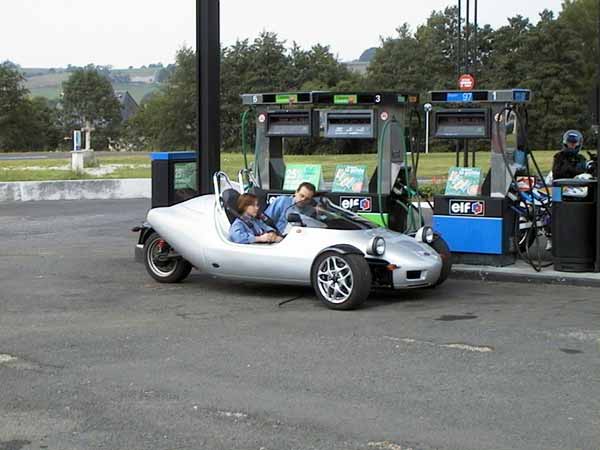
Sometimes difficult
A disavantage of not using the highway is the availability of gas. In many placs, it is hard to find gas after six or on sunday.
So fill your tank before six. Sometimes, you just have to go to a bigger town, and ask people for the one gas station that is open.
Credit-cards are nowadays almost always "truly" international (they used to give headaches). That's good, because in many countries you will have to turn to unmanned gas stations.
Don't ride on till the last drop
In some countries or regions, gas stations are scarse. In such a place, don't ride until you hit reserve, but just fill the tank when you encounter a gas station, and your tank is more than halfway empty.
Boats
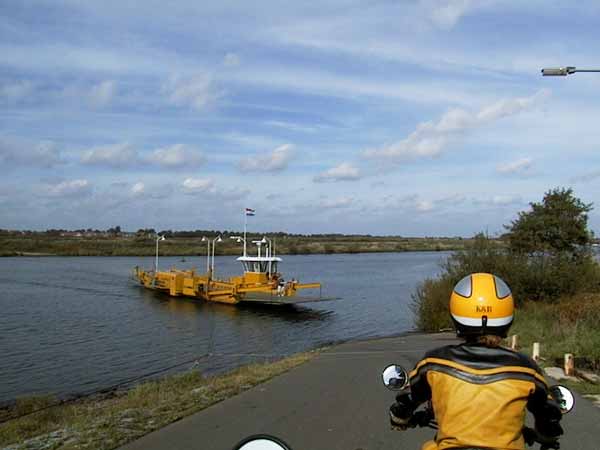
For when you cross a sea:
Secure your bike
On the big ferries, you will have to secure your bike. Always put your bike on the side-stand; not on the centerstand: there will be less chance that it will fall that way.
There is always rope on a ferry, but to be sure, take some extra straps with you.
Pull the rope under the buddy, to secure your bike. When you would pull it over the buddy, there is a big chance that you will damage it permanently.
Remember that a boat may roll and pound. So the bike will not only try to move from left to right and vice-vesa, but also forward and backward and up and down. So, apart from securing the bike with rope, put it in first gear and keep the front-brake in with a piece of rope or something like that.
In most ferries, all bikes are put together. In that case, try to help others when they don't know what to do. This is for your own concern as well, because it's not a nice sight when you return, and your bike did not fall, but your neighbour's bike did, on yours...
Huts
The cheap huts of a ferry are often below, very near the engine. Good for a terrible noise: your ear plugs won't help you here. So you cab just as well take a cheaper sleeping chair, and put your sleeping bag on the ground.
Most of the time, the hold containing your motorcycle will be closed during the trip. So take with you everything you might need, especially when the trip is a long one. You can't go to your motorcycle to get the toothbrush from your tankbag...
Riding Style
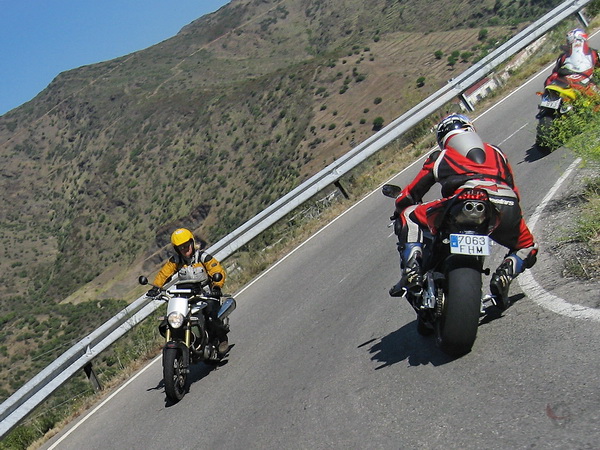
Take it easy
When you're traveling long distances, you'd better not chase the guys in this photo. Instead, try to ride as "even" as possible.
That doesn't mean that you should be slow, but it means that you'd better stay off the brakes, and don't open or close the throttle.
Far ahead
To achieve almost constant speed, without having to brake or to open the throttle, means that you have to look far ahead.
You will then be able to lower the speed by closing the throttle a bit, gently, wthout having to hit the brakes.
The pace
For some people, it is natural to ride that way; for others, it almost seems impossible.
When you adjust your riding style to what has been named the Pace, you will notice that your average speed will be about the same as it used to be, but that you will be much less fatigued after a day of riding.
Comments, Q & A, on a separate page




